As I mentioned in the previous post, these heaters have a standard interface that’s used for control & diagnostics, the W-Bus. This is transmitted over the K-Line of the vehicle bus, and all heaters, regardless of firmware modifications done by the various car manufacturers respond to this interface. Official Webasto diagnostic adaptors are available, but these are just a very expensive serial adaptor. A much cheaper option is a ~£5 Universal ODB adaptor.
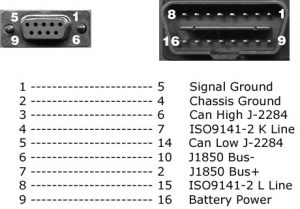
Above shows the signals on the ODB connector – the ones we’re interested in here are Pin 16, the +12v supply, and Pin 7, K-Line. Connect Pin 16 to the positive supply to the heater, and Pin 7 to Pin 2 on the Webasto heater. (Valid for all TT-V heaters).
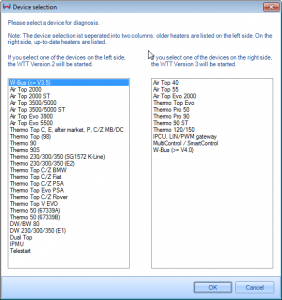
Once these two connections are made to the heater, fire up the Thermo Test software. The screen above will be displayed. Pick W-Bus at top left.
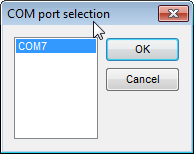
First thing, connect the ODB adaptor to USB, and change to the correct COM port in Thermo Test. There may be several in the list, but a newly connected USB device should show up with the highest COM number.
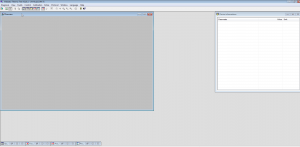
Once Thermo Test is running, start communications by going to the Diagnosis Menu > Start Diagnostic (F2 keyboard shortcut).
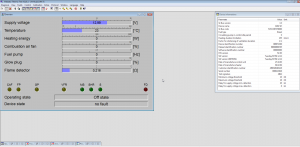
After a few seconds, communication will be established. This will show faults, if any are present, and allow testing of the heater & it’s component parts. A summary report can be generated with Diagnosis > View Summary:
Diagnosis report Webasto Thermosystems ------------------------------------------------------------------------------------------ Configuration: -------------- W-Bus version...............................................................3.3 Device name.............................................................X204 SH W-Bus code.......................................................715CC0E73F8000 Fuel type................................................................Diesel Circulating pump in control idle period.......................................0 Heating duration limitation.................................................255 [min] Factor for shortening of ventilation duration...............................1/1 Device identification number..........................................09007236E Dataset identification number.......................................09006806H05 Software identification number........................................000000000 HW version................................................................51/03 SW version..................................................Tuesday/07/04 12.12 SW version (EEPROM).........................................Tuesday/07/04 12.12 Date of manufacture control unit.......................................27.10.03 Date of manufacture heater.............................................04.02.04 Customer identification number.....................................4R8318K463AE Serial number........................................................0000123626 Test signature.............................................................4B42 Minimum voltage threshold....................................................10 [V] Maximum voltage threshold....................................................16 [V] Delay for supply voltage min. detection......................................20 [s] Delay for supply voltage max. detection.......................................6 [s] Operating data: --------------- Working hours.............................................................44:03 [h:m] Operating hours.........................................................5388:08 [h:m] Start count...............................................................19129 Burning duration PH 1..33%.................................................0:00 [h:m] Burning duration PH 34..66%................................................0:00 [h:m] Burning duration PH 67..100%...............................................0:00 [h:m] Burning duration PH >100%..................................................0:00 [h:m] Burning duration SH 1..33%.................................................0:00 [h:m] Burning duration SH 34..66%................................................0:00 [h:m] Burning duration SH 67..100%...............................................0:00 [h:m] Burning duration SH >100%..................................................0:00 [h:m] Working duration PH........................................................0:51 [h:m] Working duration SH......................................................121:10 [h:m] Start counter PH..............................................................6 Start counter SH............................................................854 Ventilation duration.......................................................0:00 [h:m] Error: ------ ------------------------------------------------------------------------------------------ 12.03.17 17:17:30 Webasto Thermo Test 2.16.1
This shows all the important stuff, including running hours. (5388Hrs on this heater!). Most importantly, there are no faults listed.
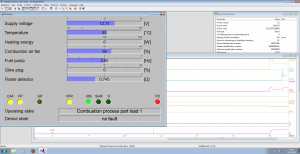
The heater can be fully tested by issuing a start command from the Command Menu > Parking Heating option. Obviously cooling water will be required for this, along with an external water pump. (The water pump control output on these heaters seems to be totally disabled in firmware, as they rely on the engine’s coolant pump). I used a bucket of water along with a small centrifugal pump to provide the cooling. During this test I noted that the firmware is much more aggressive in these units. The marine versions shut down at ~72°C water temperature, whereas these don’t so the same until ~90°C.
Now I’ve managed to communicate with the heater, I’ll get onto building a standalone controller so I can dispense with the Windows VM for control.

hello. I have a heater out of the jaguar s type. what kind do you use to make the heater run without the diagnostic software?
best wishes
Zee
Hi Zee,
An Arduino with the right software & K-Line interface works well. There’s a video from someone else over on YouTube https://www.youtube.com/watch?v=6zZjSFef4yA
I’ve used that sketch personally on the heater I have, and it works fine. A L9637D interface IC is used to talk to the heater ECU.
HI is anyone making a stand alone controller that I can buy , I have one also and I was impressed by it’s condition as compared with my
thermotop Z which goes seriously black and smokes alot
Hi Pinelpot,
As far as I am aware, nobody is making standalone controllers, but I do plan to sort a design out for a self-build controller soon!
As for your heater smoking a lot, it might need a complete disassembly for cleaning, black smoke is partially burned fuel, so it’s either getting too much fuel, or not enough air!
Cheers for reading,
2E0GXE
Hi again I have given it a major service and replaced the gauze it still smoke’s, plus it not powerful enough for my motorhome, if it’s 5kw then I was thinking of using two, but I wouldn’t buy another Z, I’ll just have to wait for your own system, or bite the bullet on some thing else
Cheers
Hi,
It sounds like the burner in the unit you have is way past prime, these can be replaced as an assembly, plus the heat exchanger is probably clogged up with scale if it’s had heavy enough use to wreck the burner – this would certainly lower the heat output somewhat.
The unit I’ve recently fitted to our boat is a Thermo Top C model, these are available pretty cheap on eBay, and are much easier to use than the automotive types as they accept a simple ON/OFF signal on a single wire.
There is an ebay seller [onlywithpaypal] who makes stand alone w-bus converters for about £40. “Analog to w-bus konverter”
Give it 12V signal and it outputs the w-bus command to start the heater.
Hi,
You’re right. I forgot those were available. Found them a while back but thought they were very expensive for their purpose.
de 2E0GXE
Hi
I am following your Webasto Thermo Top V part 1 and 2 with great interest. I have sourced a similar unit to install a small central heating system into my sailing yacht.
My question is have you managed to overcome the start up of the heater without using the diagnostic programme on your PC. Thanks in advance Richard
Hi Richard,
Unfortunately not, as I haven’t had the time to experiment with this for quite a while!
Hello, it would be fantastic to know if you have progressed this any further?